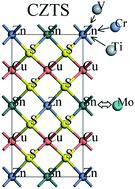当前位置:
X-MOL 学术
›
CrystEngComm
›
论文详情
Our official English website, www.x-mol.net, welcomes your feedback! (Note: you will need to create a separate account there.)
Impact of various dopant elements on the electronic structure of Cu2ZnSnS4 (CZTS) thin films: a DFT study
CrystEngComm ( IF 3.1 ) Pub Date : 2020-08-04 , DOI: 10.1039/d0ce00802h Andrey A. Kistanov 1, 2, 3, 4 , Wei Cao 1, 2, 3, 4 , Marko Huttula 1, 2, 3, 4 , Salavat Kh. Khadiullin 5, 6, 7 , Elena A. Korznikova 7, 8, 9, 10 , Aliaksandr Smirnov 11, 12, 13 , Xinghui Wang 14, 15, 16, 17, 18 , Siarhei Zhuk 11, 12, 13
CrystEngComm ( IF 3.1 ) Pub Date : 2020-08-04 , DOI: 10.1039/d0ce00802h Andrey A. Kistanov 1, 2, 3, 4 , Wei Cao 1, 2, 3, 4 , Marko Huttula 1, 2, 3, 4 , Salavat Kh. Khadiullin 5, 6, 7 , Elena A. Korznikova 7, 8, 9, 10 , Aliaksandr Smirnov 11, 12, 13 , Xinghui Wang 14, 15, 16, 17, 18 , Siarhei Zhuk 11, 12, 13
Affiliation

|
New structures made based on Cu2ZnSnS4 (CZTS) by substitutions with Cr, Ti, V, and Mo species were investigated via density functional theory. The total substitution of Zn by Cr and V leads to the vanishing of the bandgap, while n-type conductivity with a low bandgap of 0.19 eV was predicted in the case Ti. In addition, the conduction band minimum and valence band maximum overlapping were observed for the Mo/Sn ratio of 1/3. Therefore, our study suggests that even the low content of alternative cations in CZTS allows to control its band alignment. The obtained results can be helpful for designing CZTS-based intermediate layers to improve the quality of the back interface of the CZTS thin-film solar cells.
中文翻译:

DFT研究:各种掺杂元素对Cu2ZnSnS4(CZTS)薄膜电子结构的影响
通过密度泛函理论研究了基于Cu 2 ZnSnS 4(CZTS)替代Cr,Ti,V和Mo物种的新结构。用Cr和V完全取代Zn会导致带隙消失,而在Ti的情况下,n型电导率的低带隙为0.19 eV。另外,对于Mo / Sn比为1/3,观察到导带最小和价带最大重叠。因此,我们的研究表明,即使CZTS中替代阳离子的含量较低,也可以控制其能带排列。获得的结果有助于设计基于CZTS的中间层,以提高CZTS薄膜太阳能电池背面的质量。
更新日期:2020-09-14
中文翻译:

DFT研究:各种掺杂元素对Cu2ZnSnS4(CZTS)薄膜电子结构的影响
通过密度泛函理论研究了基于Cu 2 ZnSnS 4(CZTS)替代Cr,Ti,V和Mo物种的新结构。用Cr和V完全取代Zn会导致带隙消失,而在Ti的情况下,n型电导率的低带隙为0.19 eV。另外,对于Mo / Sn比为1/3,观察到导带最小和价带最大重叠。因此,我们的研究表明,即使CZTS中替代阳离子的含量较低,也可以控制其能带排列。获得的结果有助于设计基于CZTS的中间层,以提高CZTS薄膜太阳能电池背面的质量。


























 京公网安备 11010802027423号
京公网安备 11010802027423号